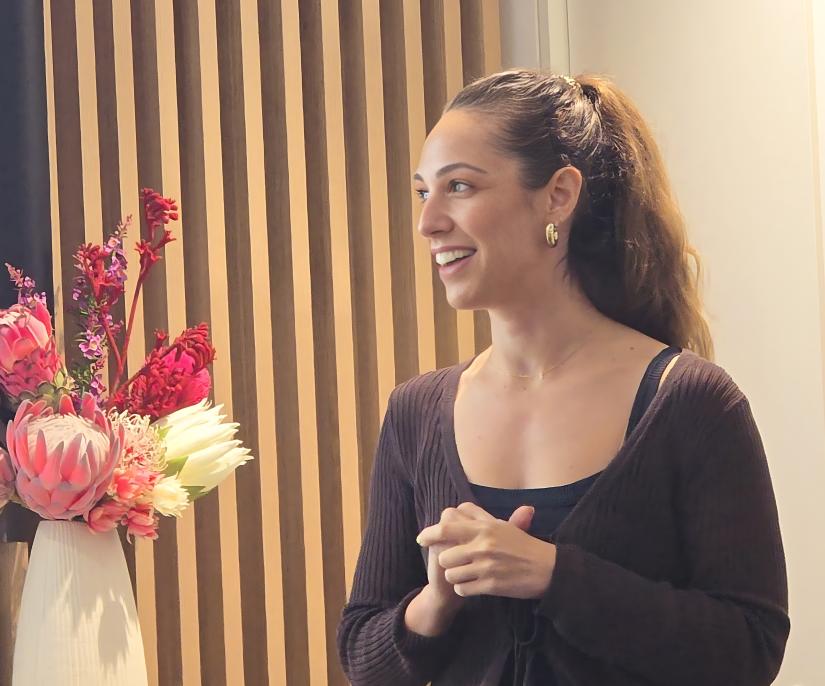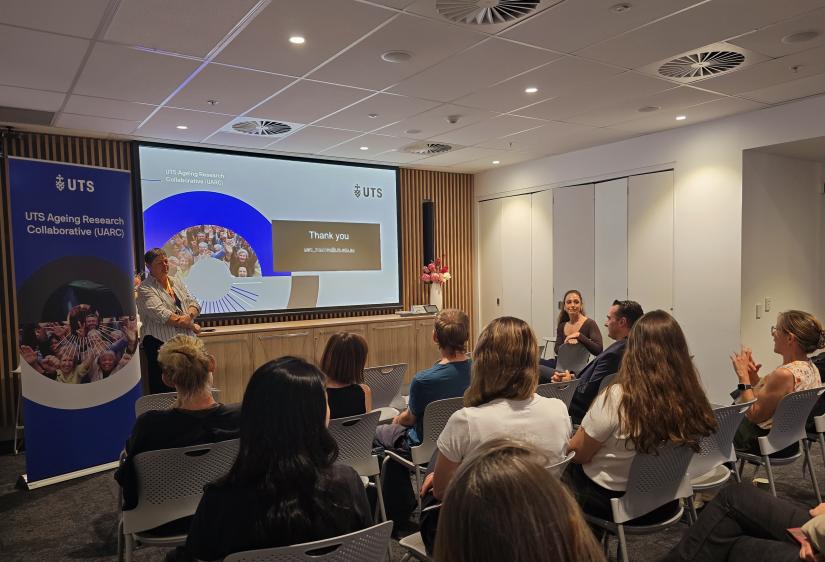With support from the UTS Strategic Research Accelerator Program, Dr Serra Ivynian and her UARC colleagues are developing the first transdisciplinary project from the UTS Ageing Research Collective (UARC) to build a decision-making tool for older Australians.
A decision-making tool for older Australians

Caption
Dr Serra Ivynian speaking in RES Hub
A Research Fellow based in the Improving Palliative, Aged and Chronic Care Through Clinical Research and Translation (IMPACCT) Research Centre within the UTS Faculty of Health, Serra presented at a recent UARC seminar.
“The Strategic Research Accelerator Program is about solving complex problems,” Serra said. “The program supports and fast-tracks mature stage research with a validated proof of concept. Its aim is to enable transdisciplinary projects to grow and deliver global impact.”
Serra said that successful projects explore new ways of working and connect different conceptual disciplines to solve complex societal problems like climate change, economic, health, and social inequalities and achieving healthy ageing.
The program supports and fast-tracks mature stage research with a validated proof of concept. Its aim is to enable transdisciplinary projects to grow and deliver global impact.
“The problem we want to address with our Strategic Research Accelerator funded project is ageing well in Australia. What currently exists to support older Australians is a fractured system where there is little communication between decision-making bodies.”
Supporting decision-making in later life
“The objective of our project is to address the problem of a fractured, exceedingly difficult to navigate aged care system in Australia where decisions are often made in a time of crisis and with insufficient information,” Serra said.
The team is building a digital decision-making tool for older Australians and their carers to enable a personalised and holistic guide for decisions related to aged care services, financial, health, legal, social and care considerations.
Using a transdisciplinary approach, the team is co-designing the project with consumers, representatives, policy makers and care organisations.
“We are building a tool to significantly improve the ageing experience for older Australians,” Serra said. “Our work embodies this new way of working, connecting different conceptual and disciplinary contexts.”
Our work embodies this new way of working, connecting different conceptual and disciplinary contexts.
The team’s precedent study revealed that from 50 tools available online, there was only one multidisciplinary tool that covered finance, legal issues, health and housing.
However, this tool is targeted towards professional planners rather than consumers.
“One conclusion we drew from this initial study was that there are limited consumer-oriented multidisciplinary planning tools,” Serra said.
Understanding the care needs of an older consumer
The team has developed nine, evidence-based archetypes to understand the needs and preferences of a variety of different users that could potentially use a digital tool as a way to facilitate user-centred design for older people.
Serra’s team then conducted co-design workshops with different stakeholders representing key bodies in ageing healthcare. Representatives from each body gave feedback on the archetypes regarding what worked, what didn’t and what was missing.
“Feedback we received included how different factors can influence planning for later life care, such as personality traits, past life experiences and education,” Serra explained.

Other factors that emerged through feedback included older people’s assumptions that their children will plan for them, their level of digital literacy and lack of skills and knowledge due to traditional gender roles.
“We found through our research that the main trigger for planning is a crisis point or significant life events such as retirement, a medical diagnosis or a death,” Serra said.
The workshops also revealed different priority areas and considerations for creating a planning tool. These included highlighting the risk of exploitation, the need to raise awareness of available services, planning for homecare and capturing broader ageing related needs, including scenario-based features, and simple navigation.
Developing a prototype
Serra and her team took the data from these workshops and ran a design sprint, developing and testing a prototype and discussing what the tool should look like.
“What came out of the design sprint was the importance of understanding what matters to consumers, their individual values and the importance of presenting information that aligns with those values.”
The team took the design sketches to consumers and then to UTS Rapido to build an initial prototype. Serra said that the initial design looked more like a website with too much information and difficult navigation.
What came out of the design sprint was the importance of understanding what matters to consumers, their individual values and the importance of presenting information that aligns with those values.
“We didn’t want that. We wanted something that was interactive, and we wanted something that was integrated,” she said. “So not just taking health, housing and finance information and having it all separate, but actually integrating them somehow.”
With the help of UTS Rapido, the team developed a completely new interactive and user-friendly design where the tool is populated based on individual user needs with tailored information and options.
In conclusion, Serra said that solving a complex problem is definitely not linear.
“The next step for our team is to test the concept and prototype with consumers and consumer representatives then analyse and incorporate the feedback into the design.”
What’s next?
- Apply for the UTS Strategic Research Accelerator Program. Applications close 31 October. Visit the SRA SharePoint to learn more.
- Learn more about UARC.
- Connect with UARC via email to be informed about the next seminar in the UARC Research Seminar Series.